7 Small-Cap Stock Picks to Watch in 2025
Are you searching for the next breakout opportunity as markets shift in 2025? The small-cap stock universe is buzzing with potential for investors ready to spot tomorrow’s leaders.
In this article, we’ll reveal seven small-cap stock picks that stand out for their growth and innovation. You’ll get background on each company, learn about their growth drivers, understand the risks, and see what makes them compelling choices.
Discover how small-cap opportunities can transform your portfolio. Get inspired, fuel your curiosity, and take action with these actionable ideas for the year ahead.
What Are Small-Cap Stocks?
Understanding what qualifies as a small-cap stock is essential for any investor looking to tap into the next wave of market growth. A small-cap stock refers to a publicly traded company with a market capitalization typically between $300 million and $2 billion. This classification sits between micro-cap companies, which are even smaller, and mid-cap or large-cap firms with much higher valuations.
Market cap is calculated by multiplying a company's share price by its total outstanding shares. This figure determines which category a stock falls into and helps investors gauge its relative size and risk profile. With more than 1,400 small-cap stocks trading on US exchanges, this space represents a significant portion of the market.
To illustrate the differences, see the table below:
| Category | Market Cap Range | Example Firms |
|---|---|---|
| Micro-cap | <$300M | Early-stage biotech |
| Small-cap | $300M - $2B | Emerging tech firms |
| Mid-cap | $2B - $10B | Regional banks |
| Large-cap | >$10B | Household tech names |
Many well-known companies, such as Netflix and Monster Beverage, began as a small-cap stock before experiencing explosive growth. This underscores the potential for outsized returns in this segment, where innovative ideas and nimble business models can quickly scale.
Definition and Market Cap Ranges
The appeal of the small-cap stock category lies in its unique blend of opportunity and risk. Historically, small-cap stocks have delivered above-average returns during bull markets, often outpacing their larger counterparts. This is partly because these companies can grow revenues and profits at a faster rate from a smaller base.
However, investing in small-cap stocks also means accepting higher volatility. Share prices can swing widely due to limited trading volume and sensitivity to economic shifts. Sectors like technology, biotech, financials, and consumer goods are commonly represented among small-cap stocks, offering a wide range of choices for investors.
After market downturns, small-cap stocks have often rebounded strongly, sometimes outperforming large caps for several years. According to Small-cap stocks' post-recession performance, this pattern has repeated across multiple cycles. For example, companies like Domino’s Pizza and Tesla once traded as small-cap stocks before becoming market giants.
Investors are drawn to small-cap stocks for the chance to participate in the early stages of a company's growth journey. While the risks are real, so is the potential for discovering the next breakout winner.
Key Trends Shaping Small-Cap Stocks in 2025
As we look toward 2025, the small-cap stock landscape is being shaped by a unique mix of economic shifts, sector innovation, and changing investor behavior. Understanding these trends is essential for anyone hoping to uncover the next wave of opportunity in this dynamic market segment.
Economic and Market Drivers
Several major forces are set to influence small-cap stock valuations in 2025. First, interest rates remain a critical factor. If the Federal Reserve continues a cautious approach, small-cap stock performance could benefit from lower borrowing costs and improved access to capital. Inflation is expected to moderate, which may help stabilize input costs for smaller companies and boost consumer confidence.
Economic growth projections for 2025 are modest but positive, providing a supportive backdrop. Sector-specific trends are also emerging. Technology innovation is accelerating, especially in cloud software and artificial intelligence, giving a boost to small-cap stock names in the tech sector. Healthcare is seeing rising demand as demographics shift, while the energy transition is fueling growth in mining and renewables.
Mergers and acquisitions are another key trend. With larger firms seeking growth by acquiring nimble, innovative players, small-cap stock holders could see premium buyouts. Recent IPOs have also added fresh entrants to small-cap indices, increasing competition and opportunity.
For a deeper dive into how interest rates, inflation, and policy could impact the small-cap stock space, see this analysis on factors influencing small-cap stocks.
Investor Sentiment and Institutional Interest
Investor interest in small-cap stock picks is rebounding as large-cap valuations reach new highs. Institutional investors are taking notice, rotating funds into this segment to capture potential upside. This shift often brings more analyst coverage and liquidity, making small-cap stock investing more accessible.
Retail investors are also playing a bigger role. The rise of online brokerages and no-commission trading has empowered individuals to discover and trade small-cap stock ideas more easily. Social media and financial news platforms are amplifying trends and creating buzz around emerging companies.
ETF flows provide another window into sentiment. In 2024, small-cap ETFs like IWM and SLY saw multi-billion dollar inflows, reflecting renewed confidence in the sector. These funds help investors gain diversified exposure to small-cap stock opportunities without the risk of picking individual names.
Together, these trends suggest that 2025 could be a pivotal year for small-cap stock investors, with macro factors and shifting sentiment setting the stage for both volatility and potential rewards.
How to Evaluate Small-Cap Stock Picks
Identifying a promising small-cap stock requires more than just a glance at the price chart. Investors need a structured approach to separate potential winners from risky bets. Let’s break down the essential steps to evaluate a small-cap stock in today’s market.
Fundamental Analysis
Start your small-cap stock evaluation with a deep dive into the company’s financials. Revenue growth is a key sign of business momentum, especially for emerging firms. Look for consistent increases in sales over several quarters or years.
Profitability matters too. Check metrics like gross margin, operating margin, and net income. A small-cap stock can be exciting, but without a clear path to profitability, it may not be sustainable. Pay close attention to debt levels and the company’s ability to manage obligations. Understanding the debt-to-equity ratio explained can help you gauge whether the business is overleveraged.
Cash flow is another critical metric. A company that generates positive operating cash flow is often better positioned to weather market volatility. Don’t overlook management quality. Executives with a track record of success, high insider ownership, and transparent communication add credibility to a small-cap stock.
Finally, assess what makes the product or service unique. A differentiated offering, whether through technology, brand, or customer loyalty, can set a small-cap stock apart in a crowded field.
Technical and Market Factors
Beyond financials, technical and market indicators offer valuable insight into a small-cap stock’s prospects. Analyze trading volume to ensure there’s enough liquidity for buying and selling without significant price impact.
Price momentum can signal growing investor interest. Look at trends over weeks or months to spot upward movement. Analyst coverage is often limited for small-caps, so even a few positive reports can move the needle.
Liquidity is vital. Wide bid-ask spreads can make entering or exiting a small-cap stock expensive. Compare historical performance to peers in the same sector. This context helps investors spot outliers and avoid stocks that lag behind industry averages.
Peer comparison tables can also highlight strengths and weaknesses:
| Metric | Stock A | Stock B | Industry Avg |
|---|---|---|---|
| Revenue Growth | 15% | 10% | 12% |
| Debt-to-Equity | 0.5 | 1.2 | 0.8 |
| Analyst Coverage | 3 | 1 | 2 |
Use these benchmarks to guide your small-cap stock decisions.
Risks and Red Flags
Every small-cap stock carries unique risks. Business model viability is a frequent concern, especially for companies with a single product or unproven market. Regulatory changes can quickly impact earnings, particularly in sectors like biotech or finance.
Competitive threats are real. Larger rivals can outspend or outmaneuver a small-cap stock. Watch for overhyped stories, such as biotechs with only one drug candidate or tech firms with untested platforms.
To mitigate these risks, diversify your holdings across sectors and industries. Conduct thorough due diligence before making a purchase. Regularly review company filings, press releases, and market news. By staying vigilant, investors can spot warning signs early and make informed small-cap stock choices.
7 Small-Cap Stock Picks to Watch in 2025
Curious about which small-cap stock could become tomorrow’s breakout winner? In this section, we spotlight seven promising companies, each offering a unique angle for growth, resilience, or innovation. Whether you’re a seasoned investor or new to the small-cap stock universe, these picks provide a diverse mix of sectors and strategies to consider for 2025.
Yelp Inc. (YELP)
Yelp Inc. remains a household name in the local business review arena. With a recent stock price near $31.48 and a market cap around $1.99B, it sits at the upper end of the small-cap stock range.
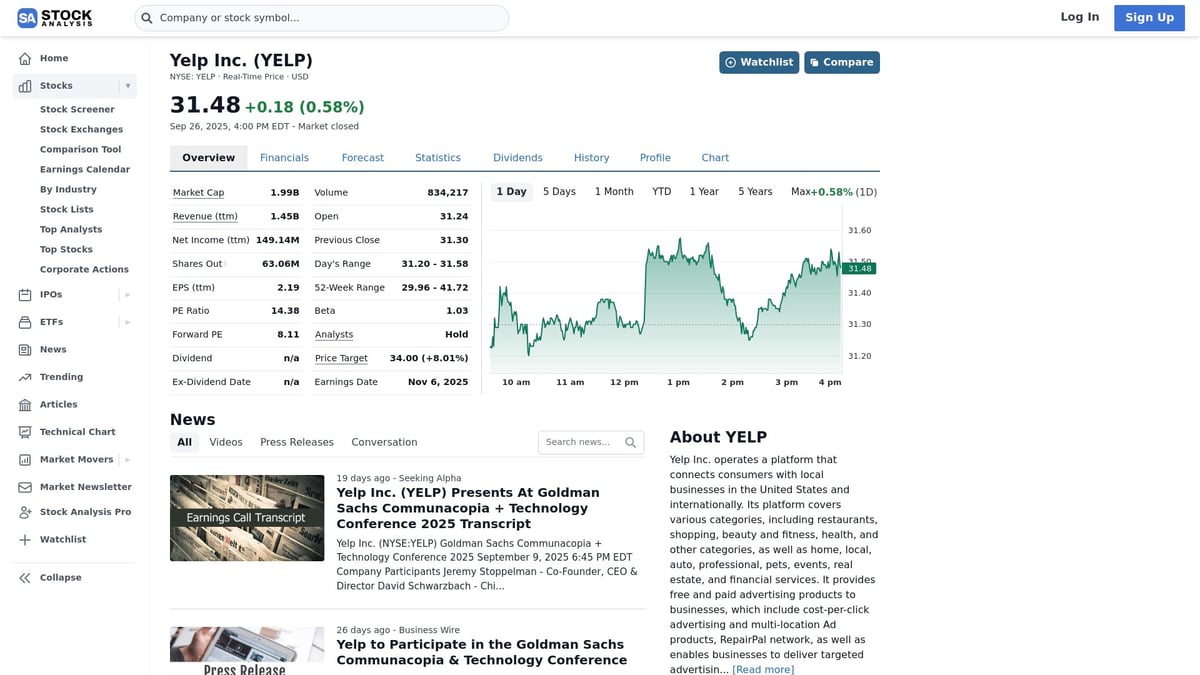
Yelp’s core strength is its robust platform for local business discovery and advertising. The company’s loyal user base fuels consistent engagement, driving resilient ad revenue even during economic uncertainty.
- Key benefits: Digital transformation, loyal audience, new service categories.
- Target audience: Local businesses, advertisers, everyday consumers looking for trusted reviews.
- Pros: Strong brand recognition, cash-positive operations, expanding into service bookings.
- Cons: Faces stiff competition from Google and specialized review apps, ad revenue can be cyclical.
The unique selling point for this small-cap stock is its dominance in local reviews and the untapped potential of its service marketplace, making it a compelling watch for investors seeking digital growth stories.
Iridium Communications Inc. (IRDM)
If you’re searching for a small-cap stock with truly global reach, Iridium Communications stands out. Priced around $17.65 with a market cap of $1.87B, Iridium operates a worldwide satellite communications network.
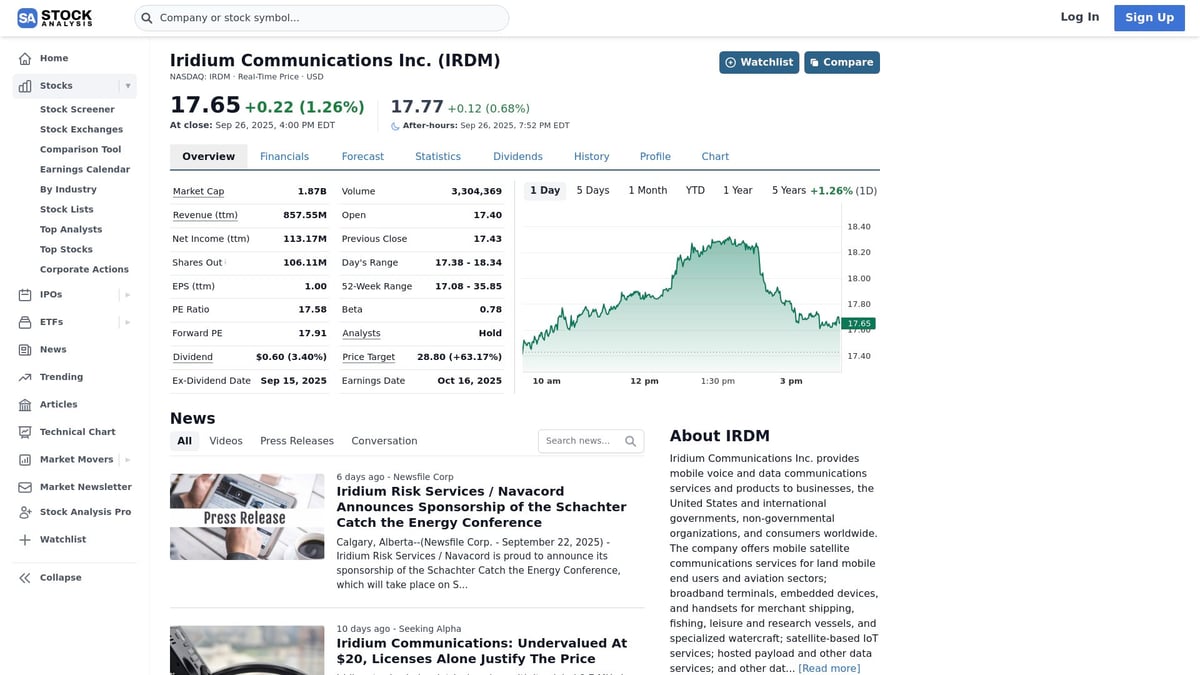
Iridium’s infrastructure is a significant barrier to entry for competitors. The company generates recurring service revenue from government contracts and commercial clients in sectors like maritime, aviation, and defense.
- Key benefits: Recurring revenue, low churn, expanding IoT applications.
- Target audience: Industries needing reliable remote connectivity.
- Pros: Unique satellite network, high entry barriers, new IoT growth channels.
- Cons: Capital intensive, technology risks, dependency on government budgets.
What makes this small-cap stock unique is its position as the only truly global provider of satellite voice and data, capturing a niche that’s increasingly vital for remote and mobile industries.
Vital Farms, Inc. (VITL)
Vital Farms is shaking up the food industry with pasture-raised eggs and butter. Trading near $42.30 with a $1.89B market cap, this small-cap stock appeals to consumers prioritizing transparency and sustainability.
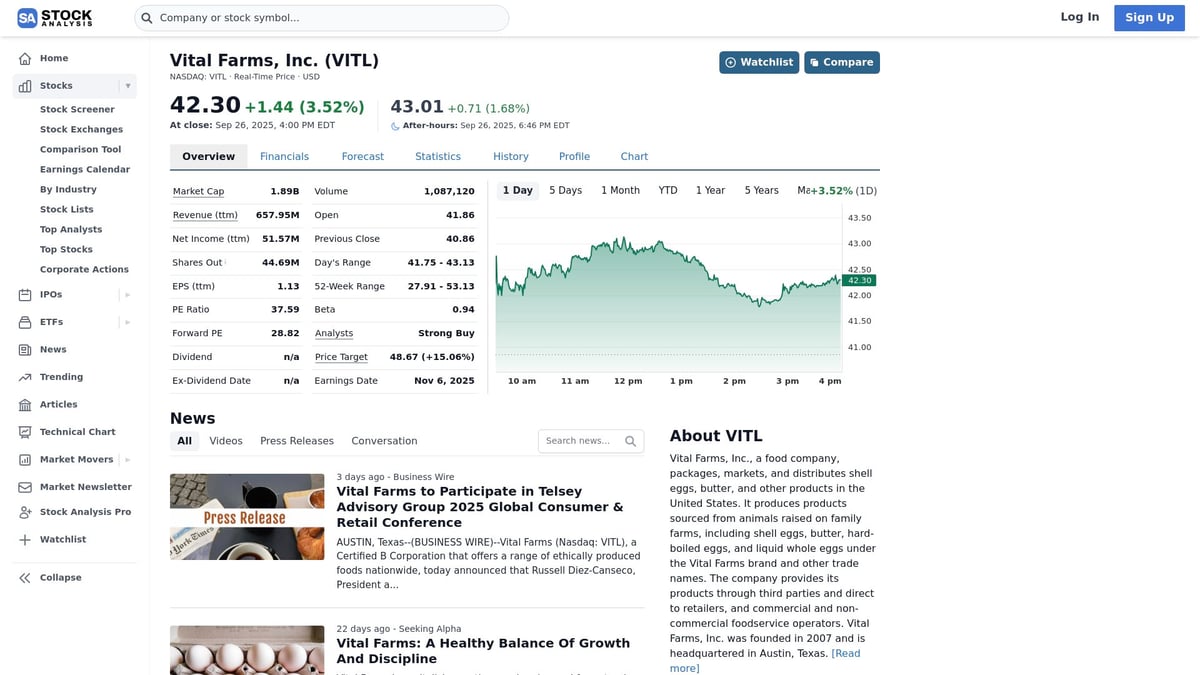
The company’s transparent supply chain and ESG-friendly focus have built strong brand loyalty. Vital Farms enjoys premium pricing power and is rapidly expanding its distribution to retailers and restaurants.
- Key benefits: Ethical sourcing, premium branding, growing demand for healthy food.
- Target audience: Health-conscious shoppers, ethical investors, food service channels.
- Pros: Expanding distribution, strong sales growth, premium positioning.
- Cons: Vulnerable to commodity price swings and supply chain hiccups.
Vital Farms’ unique selling point is its leadership in the premium egg market, making it a small-cap stock to watch as consumers increasingly demand ethical and sustainable food options.
Five9, Inc. (FIVN)
Five9 is a leader in cloud-based contact center solutions, with a share price near $25.12 and a market cap of $1.94B. This small-cap stock is riding the wave of digital transformation as businesses move customer service operations to the cloud.
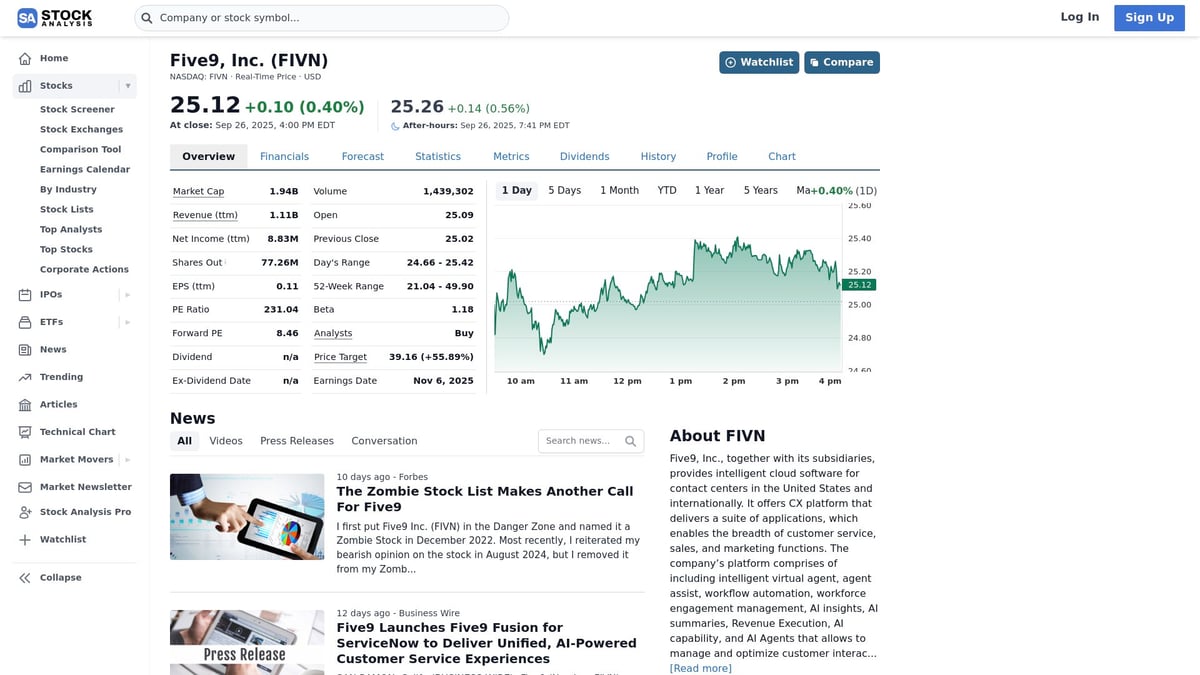
The company’s software integrates AI-powered automation, helping enterprises improve customer service efficiency. Five9’s recurring SaaS revenue and high client retention make it attractive for those seeking stability in the tech sector.
- Key benefits: Scalable SaaS model, robust partner network, AI integration.
- Target audience: Enterprises, customer support teams, BPOs.
- Pros: Early mover advantage, growing cloud adoption, sticky client base.
- Cons: Strong competition from larger SaaS vendors, pressure on margins.
Five9’s unique edge comes from its proven ability to scale and innovate, positioning this small-cap stock as a key player in the evolving contact center space.
Brookdale Senior Living Inc. (BKD)
Brookdale Senior Living is the largest operator of senior housing and assisted living communities in the US. Its stock trades at about $8.34 with a market cap close to $1.98B, fitting squarely in the small-cap stock category.

The company is well positioned to benefit from demographic shifts as the US population ages. Brookdale’s large national footprint, diverse service offerings, and real estate asset base provide stability and room for margin expansion.
- Key benefits: Demographic tailwinds, improving occupancy, healthcare partnerships.
- Target audience: Seniors, families, healthcare providers.
- Pros: Broad reach, diversified portfolio, potential for post-pandemic growth.
- Cons: Labor costs, operational complexity, regulatory oversight.
Brookdale’s unique selling point is its ability to capture the growing senior care market, making it a small-cap stock with both growth and defensive characteristics.
Sprinklr, Inc. (CXM)
Sprinklr is a unified customer experience management platform, trading at $7.86 with a $1.92B market cap. This small-cap stock leverages AI to help enterprises manage social, marketing, and customer care channels from a single dashboard.
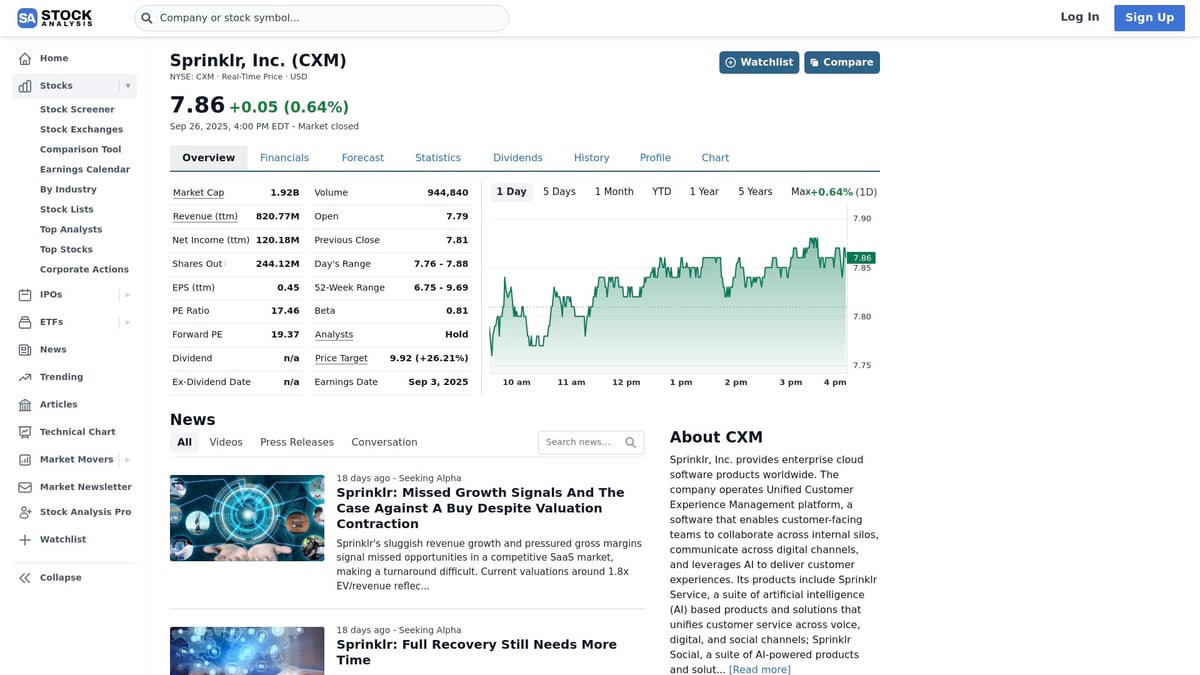
Sprinklr’s global customer base and cross-channel integration set it apart. The company continues to invest in AI and machine learning, driving innovation in customer engagement.
- Key benefits: All-in-one solution, AI-driven analytics, global reach.
- Target audience: Large enterprises, marketing and customer service teams.
- Pros: Expanding international presence, growing AI capabilities.
- Cons: Competitive SaaS market, long sales cycles.
Sprinklr’s strength lies in its comprehensive, AI-powered platform, making it a small-cap stock for investors seeking exposure to digital transformation and enterprise software trends.
Ero Copper Corp. (ERO)
Ero Copper Corp. is a mining company focused on sustainable copper production, with shares near $18.64 and a $1.93B market cap. As a small-cap stock, Ero Copper offers exposure to the surging demand for copper driven by electrification and green energy initiatives.
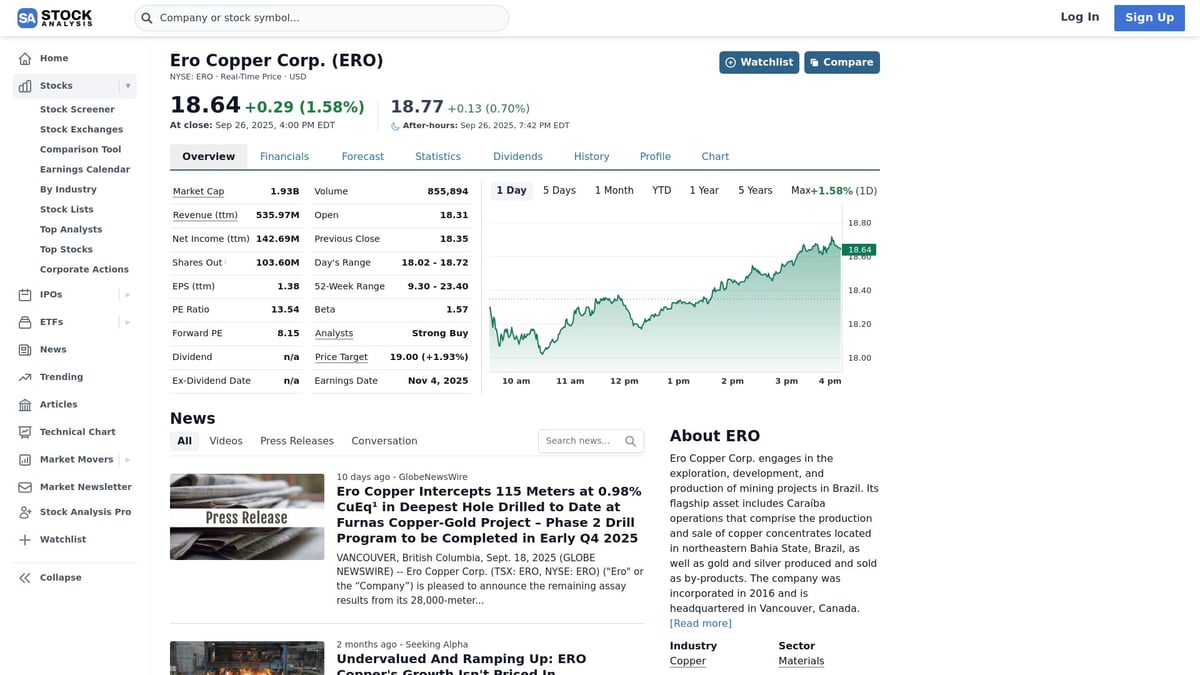
The company boasts high-grade reserves and low-cost operations, with a strong ESG focus that appeals to responsible investors. Ero Copper’s disciplined capital allocation and operational efficiency help manage risk in a volatile sector.
- Key benefits: Leverage to green energy, ESG leadership, efficient mining.
- Target audience: Industrial buyers, ESG funds, commodity investors.
- Pros: Rising copper demand, sound operations, sustainability initiatives.
- Cons: Exposure to commodity price swings, geopolitical risks.
Ero Copper’s unique selling point is its combination of sustainability and efficiency, positioning this small-cap stock as a smart play on the global energy transition.
Quick Comparison Table
| Company | Ticker | Sector | Price | Market Cap | Unique Edge |
|---|---|---|---|---|---|
| Yelp Inc. | YELP | Tech/Consumer | $31.48 | $1.99B | Local review dominance |
| Iridium Comm. | IRDM | Communications | $17.65 | $1.87B | Global satellite network |
| Vital Farms | VITL | Consumer Goods | $42.30 | $1.89B | Premium, ethical food brand |
| Five9 | FIVN | Technology | $25.12 | $1.94B | Cloud contact center leader |
| Brookdale Senior | BKD | Healthcare | $8.34 | $1.98B | National senior care footprint |
| Sprinklr | CXM | Technology | $7.86 | $1.92B | AI-driven customer experience |
| Ero Copper | ERO | Mining | $18.64 | $1.93B | Sustainable copper production |
As you can see, each small-cap stock on this list brings something distinct to the table, from digital platforms and AI to sustainable food and resource production. The recent momentum in small-cap stocks suggests that these types of companies could continue to benefit as investors seek new growth opportunities in 2025.
Sector Breakdown and Diversification Insights
Navigating the world of small-cap stock investing means understanding how sector exposure can shape both risk and reward. The seven small-cap stock picks for 2025 span a variety of industries, offering a compelling glimpse into the power of diversification.
Sector Representation Among 2025 Picks
The selected small-cap stock ideas reflect a broad sector mix:
| Sector | Example Pick | Key Trend/Catalyst |
|---|---|---|
| Technology | Five9, Sprinklr | Cloud, AI, SaaS adoption |
| Consumer Goods | Vital Farms | Ethical, premium food demand |
| Communications | Iridium | Global connectivity, IoT |
| Healthcare | Brookdale Senior Living | Aging demographics |
| Mining | Ero Copper | Electrification, green energy |
This diversity is intentional. Technology names like Five9 and Sprinklr stand to benefit from the continued surge in cloud adoption and artificial intelligence. Vital Farms, as a consumer goods leader, taps into the premiumization and ethical sourcing trend. Iridium’s communications platform leverages the global need for seamless, remote connectivity, while Brookdale rides the demographic wave of an aging population. Ero Copper, meanwhile, positions itself as a key player in the transition to green energy.
Each small-cap stock operates in a space with unique growth drivers, making sector analysis crucial for stock selection.
The Power of Diversification in Small-Cap Stock Investing
Diversifying across sectors is one of the most effective ways to manage risk in a small-cap stock portfolio. Why? Because sector-specific catalysts—like regulatory changes in healthcare or new technologies in software—can impact stocks differently.
For instance, if commodity prices become volatile and affect mining, strong performance in technology or consumer goods can help offset potential losses. Similarly, demographic trends may boost healthcare stocks even as other sectors lag. According to recent data, sector rotation is a common theme, with investors rotating into small-cap stocks as large-cap valuations rise.
Here are a few tips to harness diversification:
- Spread investments across at least three sectors.
- Look for companies with different business cycles.
- Consider how macro trends, like inflation or digital transformation, might impact each sector.
A well-diversified small-cap stock strategy helps smooth returns and reduces the impact of sector downturns.
Managing Risk and Building a Resilient Portfolio
Building a resilient small-cap stock portfolio means more than just picking winners. It’s about regular monitoring, understanding financial terms, and staying nimble.
Risk management starts with analyzing sector weights and avoiding overconcentration. For example, if the majority of your picks are in tech, a single negative event could drag down your entire portfolio. Instead, blend growth-oriented sectors with more stable ones.
Keeping up with sector performance data from 2024 and projections for 2025 can help you adjust allocations proactively. Familiarize yourself with key financial terms for investors to interpret financial statements and ratios, which are essential for evaluating small-cap stock fundamentals.
Finally, remember these portfolio-building essentials:
- Rebalance regularly to maintain sector mix.
- Stay updated on industry news and earnings reports.
- Use historical performance as a guide, but adapt to new trends.
With a disciplined approach, small-cap stock investing becomes a powerful tool for growth and risk management.
How to Research and Monitor Small-Cap Stocks in 2025
Navigating the world of small-cap stock investing in 2025 requires more than just gut instinct. Success comes from diligent research and active monitoring, especially as these stocks can be fast-moving and volatile. If you want to spot winning opportunities early, you need a systematic approach tailored for the unique challenges of the small-cap stock market.
Start by using reliable stock screeners and financial data platforms. Tools like StockAnalysis.com, Yahoo Finance, and your brokerage platform let you filter for small-cap stock candidates based on market cap, sector, or specific financial criteria. These platforms help you compare growth rates, balance sheet strength, and profitability at a glance.
When analyzing a small-cap stock, always dig into recent earnings reports, analyst upgrades or downgrades, and insider transactions. These signals can reveal shifting sentiment or potential catalysts. For example, a flurry of insider buying might suggest management’s confidence in future growth.
Liquidity and financial health matter even more with small companies. Evaluate metrics like the quick ratio, which measures a company’s ability to meet short-term obligations. You can learn more about this essential indicator in Understanding the quick ratio. Also, check if the business uses a sinking fund to manage debt repayments, as explained in What is a sinking fund?. Both factors can help you spot a small-cap stock with solid fundamentals.
Here’s a quick comparison of tools for researching small-cap stocks:
| Tool | Key Feature | Best For |
|---|---|---|
| StockAnalysis.com | Deep financial data | Screening and peer comparison |
| Yahoo Finance | News and charting | Tracking and alerts |
| Brokerage Platform | Real-time monitoring | Placing trades, watchlists |
Keep an eye on historical performance to spot patterns and anticipate future trends. Set news alerts for your watchlist, and pay attention to regulatory filings and press releases, which can move a small-cap stock quickly. Staying informed helps you react to new developments before the broader market catches on.
No matter your strategy, reviewing data regularly and diversifying your watchlist will give you an edge. The small-cap stock landscape is ever-changing, so a disciplined, tech-enabled approach is your best ally in 2025.
Exploring small cap stocks is all about spotting unique opportunities and learning from past market moves. If you’re as curious as I am about how history shapes what’s next in the markets—especially with these seven small caps to watch in 2025—why not take the next step? Our platform is designed to help you dig deeper, visualize trends, and connect the dots between yesterday’s lessons and tomorrow’s winners. Want to be part of something new and help shape a smarter investing tool from the ground up? Join Our Beta and let’s make history matter in your investment journey.
